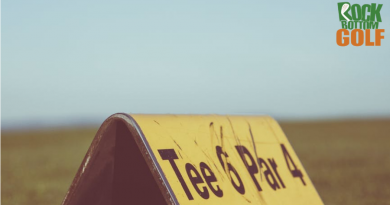Expensive Golf Balls Are Just Better…Right?
Wrong! You don’t have to spend a ton of money on golf balls to get more distance or better performance around the green. Even the bargain brands are capitalizing on new materials and manufacturing techniques to help golfers of every skill level improve their game. If you’re looking for a quick, painless and inexpensive way to shave a few strokes (and save a few bucks, too!) look no further than the top of your tee.
First, know your covers. Most of today’s balls are wrapped in either an Ionomer or Urethane cover. So what’s the difference? Urethane covers are more elastic, a little softer, and somewhat more difficult to manufacture; that means more expensive, too. Ionomer covers (sometimes called Surlyn) cost less and are more durable – you’ll find these on most of your distance golf balls. Bottom line on covers: Unless you need precise control and lots of spin, save some dough with ionomer covers. They’ll last longer and might even gain you some distance off the tee!
Next, let’s look under the hood: the core. The key here is compression, and that’s a result of swing speed. So the faster your swing, the harder the impact, and the more compressed your golf ball will become. A slow-swinging golfer hitting a “Tour” golf ball just can’t generate the force needed to see all the benefits of that premium golf ball. Bottom line on cores: A fast swing needs a high-compression golf ball to maximize your distance, while slower swings should stick to low compression cores.
Finally, let’s look at dimples in-depth. Those distinctive patterns on your golf ball serve several purposes, most related to ball flight and trajectory. The Titleist Pro V1’s 392 dimples can increase distance with a lower, longer trajectory while the Titleist DT Carry’s 252-dimple design promotes a higher loft and hang-time. And Callaway’s hexagonal dimples are engineered to neutralize drag for a longer, more stable trajectory – a straighter shot. But a poorly struck ball isn’t going to come back to straight because of its dimples, and a dimple pattern isn’t going to make or break a putt. Bottom line on dimples: Don’t buy a ball based on its dimples alone – they just don’t make that much of a difference!
Your Favorite Golfin’ Caveman – Scratch
PS: Do you love (or hate!) a particular type or brand of golf ball? Let your fellow Rock Heads know what brands to buy and what balls to boycott in the comments below!




I normally play Slazengers but you guys haven’t had any of them for a while…what gives? I will say the 2 dozen recycled titleists i got from your site last year were better than expected. I got the cheapest pack, the ‘assorted’ instead of the pro v1 or nxt or whatever. Gave some to my brother, then spent the rest of the season losing one or two here and there on water holes. So when are you going to get either those or some Slazengers back in stock scratch??
So why the heck are Pro Vs so expensive?
*** Reply From Scratch ***
Good question! But as long as people keep payin’ for ’em, that’s what they’ll keep chargin’ for ’em!
Pingback: Caveman's Chronicles: A Brief History Of The Golf Ball From Feathers, Leather & Sap To Surlyn, Synthetics & Beyond! - Golf Blog | RockBottomGolf.com